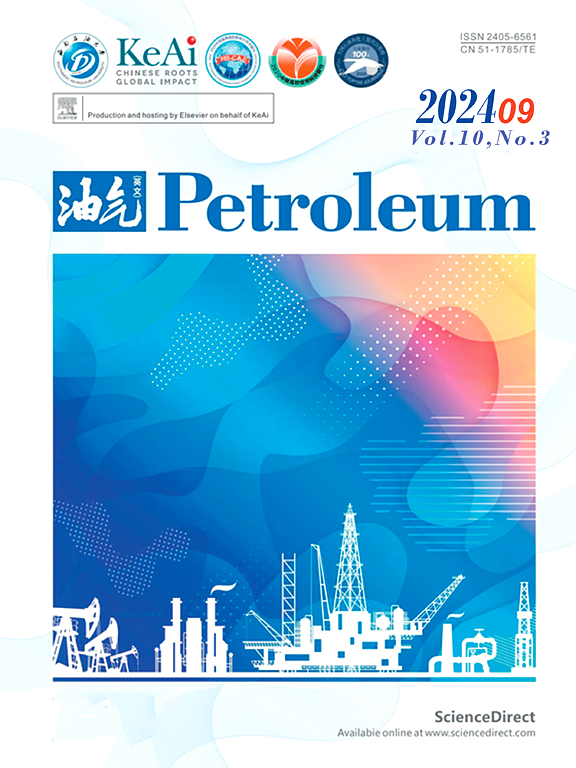Experimental evaluation method of density suitability between bridging lost circulation materials and drilling fluid
IF 4.2
Q2 ENERGY & FUELS
引用次数: 0
Abstract
Ultra-deep geological conditions are complex, often leading to leakage issues. As the depth increases during ultra-deep bridging lost-circulation operations, the varying settling velocities of different types of lost circulation materials (LCMs) lead to gravitational differentiation. This causes stratification of the LCMs, forming an unevenly dispersed system and reduced plugging efficacy. An experimental methodology is described for assessing the density suitability between LCMs and drilling fluids, which calculates the density suitability factor (DSF) by measuring the density of the plugging slurry at various locations after a designated resting period, ultimately evaluating its density suitability based on the DSF. Experimental results indicate that LCMs with lower densities demonstrate superior density suitability compared to those with higher densities. Smaller particle sizes (10–40 mesh) show better density suitability than larger ones (2–6 mesh). Fracture-plugging experiments validated this method, the plugging slurry composed of a good density suitability material, such as walnut shells, exhibited no notable gravitational differentiation after 2 h, achieving a maximum plugging pressure of 16.4 MPa with 88 mL of total volume loss. In contrast, the slurry formed with poorly density suitability materials, such as calcite, showed significant gravitational differentiation after 2 h, achieving only 9.6 MPa in maximum plugging pressure and a total volume loss of 96 mL. These findings highlight that LCMs with superior density suitability enhance plugging efficiency, highlighting the critical role of density suitability testing and the optimization of plugging formulations to improve the success of plugging operations.
桥接堵漏材料与钻井液密度适宜性的实验评价方法
超深层地质条件复杂,经常导致泄漏问题。在超深桥接堵漏作业中,随着井深的增加,不同类型堵漏材料(lcm)沉降速度的变化会导致重力分化。这会导致lcm分层,形成不均匀的分散体系,降低堵漏效果。本文介绍了一种用于评估lcm与钻井液之间密度适宜性的实验方法,该方法通过在指定的静息期后测量不同位置堵漏浆的密度来计算密度适宜系数(DSF),最终根据DSF评估其密度适宜性。实验结果表明,低密度lcm比高密度lcm具有更好的密度适宜性。较小的粒径(10-40目)比较大的粒径(2-6目)具有更好的密度适宜性。堵漏实验验证了该方法的有效性,由核桃壳等密度适宜的材料组成的堵漏浆在2 h后没有出现明显的重力分化,最大堵漏压力为16.4 MPa,总体积损失为88 mL。相反,方解石等密度适宜性较差的材料形成的泥浆在2 h后出现了明显的重力分化,最大封堵压力仅为9.6 MPa,总体积损失为96 mL。这些研究结果表明,密度适宜性较好的lcm可以提高封堵效率,强调了密度适宜性测试和优化封堵配方对提高封堵作业成功率的关键作用。
本文章由计算机程序翻译,如有差异,请以英文原文为准。
求助全文
约1分钟内获得全文
求助全文
来源期刊

Petroleum
Earth and Planetary Sciences-Geology
CiteScore
9.20
自引率
0.00%
发文量
76
审稿时长
124 days
期刊介绍:
Examples of appropriate topical areas that will be considered include the following: 1.comprehensive research on oil and gas reservoir (reservoir geology): -geological basis of oil and gas reservoirs -reservoir geochemistry -reservoir formation mechanism -reservoir identification methods and techniques 2.kinetics of oil and gas basins and analyses of potential oil and gas resources: -fine description factors of hydrocarbon accumulation -mechanism analysis on recovery and dynamic accumulation process -relationship between accumulation factors and the accumulation process -analysis of oil and gas potential resource 3.theories and methods for complex reservoir geophysical prospecting: -geophysical basis of deep geologic structures and background of hydrocarbon occurrence -geophysical prediction of deep and complex reservoirs -physical test analyses and numerical simulations of reservoir rocks -anisotropic medium seismic imaging theory and new technology for multiwave seismic exploration -o theories and methods for reservoir fluid geophysical identification and prediction 4.theories, methods, technology, and design for complex reservoir development: -reservoir percolation theory and application technology -field development theories and methods -theory and technology for enhancing recovery efficiency 5.working liquid for oil and gas wells and reservoir protection technology: -working chemicals and mechanics for oil and gas wells -reservoir protection technology 6.new techniques and technologies for oil and gas drilling and production: -under-balanced drilling/gas drilling -special-track well drilling -cementing and completion of oil and gas wells -engineering safety applications for oil and gas wells -new technology of fracture acidizing
 求助内容:
求助内容: 应助结果提醒方式:
应助结果提醒方式:


